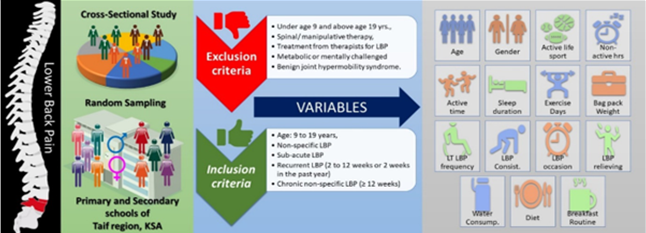Study on the occurrence and factors contributing to lower back pain in Taif region adolescents, KSA
Abstract
This study aimed to validate variables impacting the prevalence of low back pain (LBP) in adolescents, focusing on gender, age, exercise, sedentary activities, and dietary factors. A cross-sectional study with random sampling was conducted among adolescents aged 9 to 19 years, using a modified questionnaire based on the Oswestry and Roland-Morris LBP and Disability questionnaires. The response rate was 81.9%, with the highest LBP prevalence (87.5%) in 18-year-olds. Overall, 93.5% of participants reported experiencing back pain, particularly among those not actively involved in sports; notably, 63% led a sedentary lifestyle.Of the subjects, 23.5% reported sleeping 6-8 hours, 29.5% went to the gym 2-3 days a week, and 30.6% consumed over 3 liters of water daily. Additionally, 45.2% maintained a diet rich in fruits and vegetables, while 26.1% consumed high-protein foods. A good breakfast routine was linked to significantly reduced LBP. Males (59.2%) reported higher LBP frequency than females. For relief, 48.8% of males sought medical help or took medication, while 34.4% relied on self-healing methods. The study underscored the associations between various factors and LBP in adolescents and school-age children.
Full text article
Generated from XML file
Authors
Yusuf, M. . (2024). Study on the occurrence and factors contributing to lower back pain in Taif region adolescents, KSA. International Journal of Research in Pharmaceutical Sciences, 15(4), 24–33. https://doi.org/10.26452/ijrps.v15i4.4716
Copyright (c) 2024 International Journal of Research in Pharmaceutical Sciences

This work is licensed under a Creative Commons Attribution-NonCommercial-NoDerivatives 4.0 International License.





